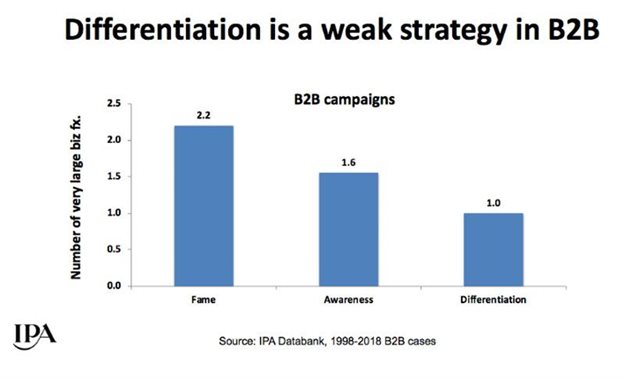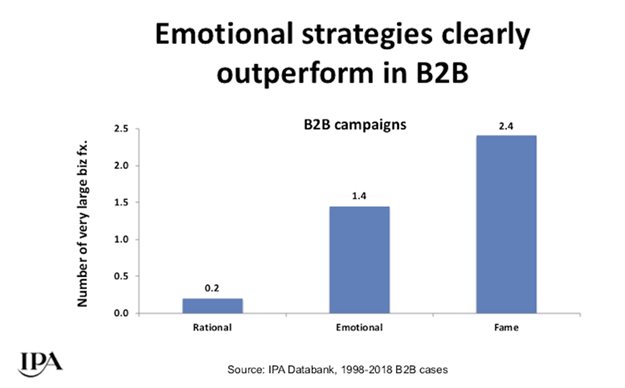#BizTrends2020: Creativity's tipping point in business

I want to talk about the trend of marketers in general, but business-to-business marketers specifically, and the executives to whom they report, realising that just over the short-term horizon is an unexplored continent of creativity where, in the words of the wonderfully articulate Martin Weigel, “disproportionate and sustained advantage awaits”.
I want to wish into existence the trend for CEOs and the other C-suite members to start understanding and absorbing the avalanche of proof about the effectiveness of creativity.For years, innovation has been a buzzword and a corporate goal in the corridors of power. What else is creativity if not innovation?
B2b should not stand for ‘Business to Boring’
If B2C advertisers struggle with short-termism and lack of creative risk-taking, then the real frontier to be broken through is in the B2B area. Currently, much B2B plays in the ‘Business to Boring’ space, relying on stock photos and images of glass skyscrapers and cheesy rational headlines.
Is this because we believe that B2B decisions are made purely on rational factors?
The simple fact is that humans work in businesses. The very humans we are attempting to win over in the B2B space are driven by emotion as much as anywhere else.This isn’t “new news” – the Nobel prize winner, Daniel Kahneman, wrote about this in his must-read book “Thinking, Fast and Slow,” where he describes the two different modes of thinking "System 1: instantaneous, driven by instinct and emotion” and "System 2: slower, driven by deliberation and logic”.
In his work, he proves that we attribute much too much importance to how ‘rational’ humans are in their decision-making: even when we think we are making rational decisions, our decision-making process is heavily influenced by System 1 beliefs, biases and intuitions.
So how do the humans we are communicating to about our business gather these beliefs, biases and opinions about our brand?
What happens in the siloes
For businesses that have both consumer and business targets, these experiences and impressions are formed in large part by their exposure to consumer advertising and experiences that embed themselves into their own personal System 1 reservoir. Funnily enough, humans don’t compartmentalise as much as our channel plans do.
Of course, we anticipate that our business customers will have seen some of our consumer advertising and activations, but somehow in the siloes, whilst the consumer marketers seem to be pushing for greater creativity based on deep insights (well, the good ones are anyway), it seems acceptable to throw that methodology in the bin and adopt a rational, fact-based approach to talk to business customers.
This is even odder when we consider the media weight, or budgets, put behind consumer vs business. There is a lot more of the consumer-facing messaging than the B2B messaging, so it would seem obvious to build on the “consumer brand” rather than to climb back down the benefits ladder to functional product attributes and differentiation.
What happens if you are a B2B brand that doesn’t have consumer-facing advertising? Can you be boring and rational then?
The answer is “No.”
The rise of human to human
The darlings of advertising effectiveness research, Les Binet and Peter Field, who recently launched their “The Long and the Short of it” report, turned their attention to the question: Does what works for B2C work for B2B?
Here’s what they found:
- 1. In terms of “the number of very large business effects reported”, brand building (long-term, strategic, creative) is 71% more effective than activations (short term, tactical).
- 2. While “fame” (or mental availability) increases B2C effectiveness by a factor of 4 and maximises profit, it is a whopping 214% more effective than activations in the B2B space.
- 3. Now to the crux of it – does emotion have a place in decision making in B2B vs rational consideration? In the B2C market, only 26% of decisions are made on rational grounds compared the B2B market where only 30% of decisions.
- 4. Differentiation turns out to be the weakest strategy compared to awareness and fame.
- 5. And in case there is any doubt left, Fame and Emotional strategies outperform Rational by over 1000%.
A survey of over 600 B2B marketers was conducted by The Marketing Practice, to understand the secrets of effective marketing, and to identify the behaviours that separate high-performing marketers from their competitors.
B2B marketers still place the most importance on the basics to drive effectiveness: In the first three places are targeting, a clear value proposition and creativity, and believe that insights and creativity will most likely help them succeed in the next five years.
Bryan Kramer, the author of “There’s no B2B, it’s Human to Human, #H2H”, tells us that there is no B2C and B2B: it is simply #H2H – Human to Human.
Unexplored continent of creativity
Creativity in brand communication based on insights that inform powerful, motivating propositions to drive big, strong strategic creative ideas has been proven to work, no matter who you’re talking to.
That’s the trend I want to see.
As Kramer says, it's time to “bring back the human side of communication, in all its imperfection, empathy and simplicity”.
It’s the trend that I think simply has to start happening.
The C-Suite of any business cannot afford to continue to ignore these factors if they want to forge ahead for growth. It’s all very well changing titles from chief marketing officers to chief growth officers, but the growth can’t easily be found without exploring that unexplored continent of creativity.

Related
2024 Effie South Africa Ipsos Trends Report reveals what drives effective marketing 3 Apr 2025 #Cannes2025: Apple named 2025 Creative Marketer of the Year 24 Mar 2025 AI in Advertising Forum – speakers and agenda announced 6 Mar 2025 2025 Effie Awards: Entry dates announced 4 Mar 2025 Call for judges: Effie Awards South Africa 2025 12 Feb 2025 Lobengula powers Effie Awards South Africa to greater industry impact 11 Feb 2025








































